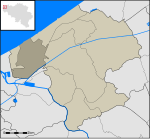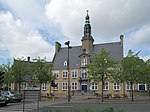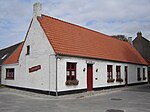Yser

The Yser (US: ee-ZAIR, French: [izɛʁ]; Dutch: IJzer [ˈɛizər] ) is a river that rises in French Flanders (the north of France), enters the Belgian province of West Flanders and flows through the Ganzepoot and into the North Sea at the town of Nieuwpoort. The source of the Yser is in Buysscheure (Buisscheure), in the Nord department of northern France. It flows through Bollezeele (Bollezele), Esquelbecq (Ekelsbeke), and Bambecque (Bambeke). After approximately 30 kilometres (19 mi) of its 78-kilometre (48 mi) course, it leaves France and enters Belgium. It then flows through Diksmuide and out into the North Sea at Nieuwpoort. During the Battle of the Yser in the First World War, by opening the sluices, part of the polder west of the Yser was flooded with seawater between Nieuwpoort and Diksmuide to provide an obstacle to the advancing German Army and keep westernmost Belgium safe from German occupation. The Yser river itself never overflowed its banks.
Excerpt from the Wikipedia article Yser (License: CC BY-SA 3.0, Authors, Images).Yser
Loodswezenplein,
Geographical coordinates (GPS) Address Nearby Places Show on map
Geographical coordinates (GPS)
| Latitude | Longitude |
|---|---|
| N 51.152777777778 ° | E 2.7230555555556 ° |
Address
Blauwvoet
Loodswezenplein
8620 (Nieuwpoort)
West Flanders, Belgium
Open on Google Maps










